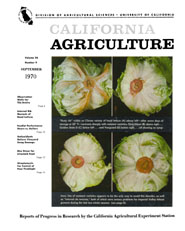All Issues

Cover:
"Rusty rib" visible on Climax variety of head lettuce (A) above left - after seven days of storag at 35* F - contrasts sharply with resistant varieties: Forty-Niner (B) above right, Golden State D (C) below left, and Vanguard (D) below right - all showing no symptoms. Use of resistant varieties appears to be the only way to avoid this disorder, as well as "internal rib necrosis," both of which were serious problems for Imperial Valley lettuce growers during the last two winter seasons.
September 1970
Volume 24, Number 9
Volume 24, Number 9





